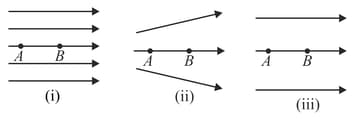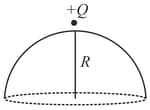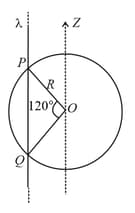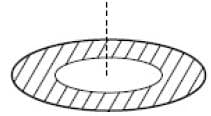Electric field in a region is increasing in magnitude along -direction. The equipotential surfaces associated are
Important Questions on Electrostatics
(i) A negative test charge experiences a force opposite to the direction of the field.
(ii) The tangent drawn to a line of force represents the direction of electric field.
(iii) The electric field lines never intersect.
(iv) The electric field lines form a closed loop.
The electric field lines on the left have twice the separation on those on the right as shown in figure. If the magnitude of the field at is , what is the force on charge kept at

The total potential at a point at distance from their common centre, where would be:
Figure shows three arrangements of electric field lines. In each arrangement, a proton is released from rest at point A and then accelerated through point B by the electric field. Points A and B have equal separations in the three arrangements. If and are linear momentum of the proton at point B in the three arrangement respectively, then

(figures are schematic and not drawn to scale)


A uniformly charged solid sphere of radius R has potential (measured with respect to ) on its surface. For this sphere the equipotential surfaces with potential and have radius , and respectively. Then
Note : This question had two option correct at the time of examination. Proper corrections are made in the question to avoid it.
A thin disc of radius has a concentric hole of radius in it (see figure). It carries uniform surface charge on it. If the electric field on its axis at a height from its centre is given as then the value of is

A charge Q is uniformly distributed over a long rod AB of length L as shown in the figure. The electric potential at the point O lying at a distance L from the end A is :

A small point mass carrying some positive charge on it, is released from the edge of a table. There is a uniform electric field in this region in the horizontal direction. Which of the following options then correctly describe the trajectory of the mass ? (Curves are drawn schematically and are not to scale)

